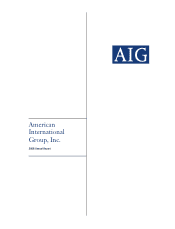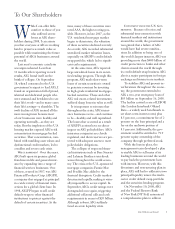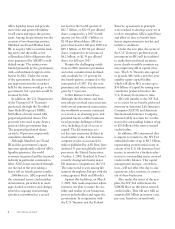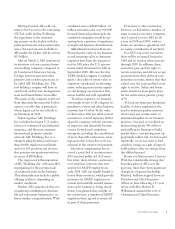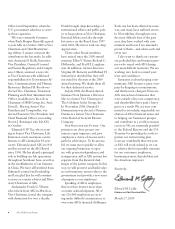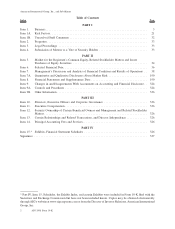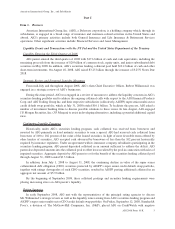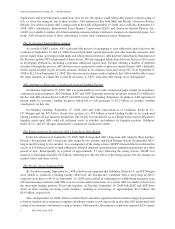AIG 2008 Annual Report Download - page 3
Download and view the complete annual report
Please find page 3 of the 2008 AIG annual report below. You can navigate through the pages in the report by either clicking on the pages listed below, or by using the keyword search tool below to find specific information within the annual report. AIG 2008 Annual Report 1
To Our Shareholders
W
hile I can offer little
comfort to those of you
who suffered severe
losses as AIG share-
holders during 2008, I can assure
you that everyone at AIG is working
hard to preserve as much value as
possible while maximizing the future
potential of AIG’s businesses around
the world.
Last year’s economic cataclysm
was unprecedented. Less than
12 months after reporting record
results, AIG found itself on the
brink of collapse. On September
18, when I consented to the U.S.
government’s request to lead AIG, I
found an organization full of proud,
talented and dedicated people who
were stunned and bewildered to see
their life’s work—and in many cases
their life’s savings—a shambles. The
swift decline of AIG seemed all the
more incongruous because most
of our businesses were healthy and
operating normally—as they are
today. But the implosion of the U.S.
housing market exposed AIG’s risk
concentration in mortgage-backed
securities. That concentration, com-
bined with tumbling asset values and
dysfunctional credit markets, led to
a sudden and severe cash crisis.
WHAT HAPPENED? Over the years,
AIG built upon its premier global
franchises in life and general insur-
ance by expanding into a range of
nancial services businesses. One
of these, created in 1987, was AIG
Financial Products Corp. (AIGFP),
a company that engaged as principal
in a wide variety of nancial trans-
actions for a global client base. In
1998, AIGFP began to sell credit
default swaps to other nancial
institutions to protect against the
default of certain securities. At the
time, many of these securities were
rated AAA, the highest rating pos-
sible. However, in late 2007, as the
U.S. residential mortgage market
began to deteriorate, the valuation
of these securities declined severely.
As a result, AIG recorded substantial
unrealized market valuation losses,
especially on AIGFP’s credit default
swap portfolio, which led to signi -
cant cash requirements.
At the same time, AIG reported
large unrealized losses in its securi-
ties lending program. Through this
program, AIG made short-term
loans of certain securities it owned
to generate revenues by investing
in high-grade residential mortgage-
backed securities. These and other
AIG real estate-related investments
suffered sharp losses in value as well.
It is important to reiterate that
throughout the crisis, AIG’s insur-
ance businesses were—and continue
to be—healthy and well capitalized.
The losses that occurred as a result
of AIGFP’s actions have no direct
impact on AIG policyholders. AIG’s
insurance companies are closely
regulated, and their reserves are pro-
tected with adequate assets to meet
policyholder obligations.
The collapse of respected nan-
cial institutions such as Bear Stearns
and Lehman Brothers sent shock
waves throughout the world econo-
my. The crisis at the U.S.-sponsored
mortgage companies Fannie Mae
and Freddie Mac added to the
nancial disruption. Credit markets
deteriorated rapidly, making it virtu-
ally impossible to access capital. In
September, AIG’s credit ratings were
downgraded once again, triggering
additional collateral calls and cash
requirements in excess of $20 billion.
Although solvent, AIG suddenly
faced an acute liquidity crisis.
INVESTMENT FROM THE U.S. GOV-
ERNMENT. Because of its size and
substantial interconnection with
nancial markets and institutions
around the world, the government
recognized that a failure of AIG
would have had severe rami ca-
tions. In addition to being one of
the world’s largest insurers, AIG was
providing more than $400 billion of
credit protection to banks and other
clients around the world through
its credit default swap business. AIG
also is a major participant in foreign
exchange and interest rate markets.
To stabilize AIG and prevent re-
verberations throughout the econo-
my, the government extended to
AIG a two-year emergency loan of
$85 billion on September 16, 2008.
The facility carried a rate of LIBOR
(the London Interbank Offered
Rate—a widely used benchmark to
set short-term interest rates) plus
8.5 percent, a commitment fee of 2
percent on the loan principal and a
fee on the undrawn portion of
8.5 percent. Additionally, the gov-
ernment would be entitled to 79.9
percent equity ownership of the
company through preferred stock.
With the loan in place, the
management team developed a plan
to enable AIG to sell many of its
leading businesses around the world
to pay back the government loan
with interest. However, with this
divestiture and restructuring plan in
place, AIG still had to address its two
principal liquidity issues: the multi-
sector credit default swap portfolio
and the securities lending program.
On November 10, 2008, AIG
and the Federal Reserve Bank
of New York (NY Fed) announced
a comprehensive plan to address

